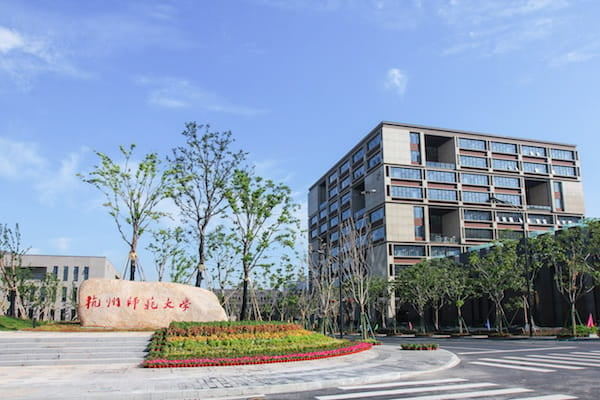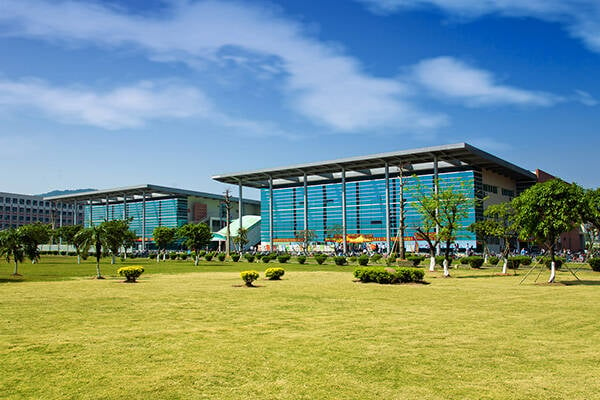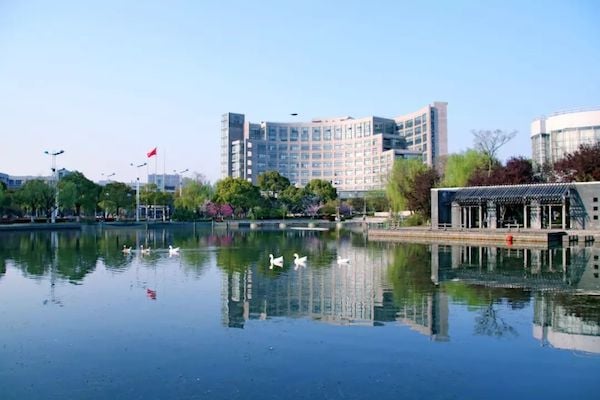 Nanjing Forestry University
Nanjing Forestry University
![]()
Introduction to Nanjing Forestry University
Nanjing Forestry University (南京林业大学, website) is located in the beautiful Zijin Mountain. It is a provincial key university jointly established by the central and local governments. In 2017, it was selected as a national “double-class” university building list. The school was formerly known as the Central University (founded in 1902) and the Department of Forestry of Jinling University (founded in 1910). The Nanjing Forestry College, which was formed in 1952, was one of the only three higher forestry colleges in the country. In 1955, the Department of Forestry of Huazhong Agricultural College (the merger of Wuhan University, Nanchang University and Hubei Agricultural College) was merged. In 1972, it was renamed Nanjing Forestry Industry College. In 1983, the name of Nanjing Forestry College was restored. In 1985, it was renamed Nanjing Forestry University.
The university covers an area of 10,725 mu, of which the Xinzhuang main campus covers an area of 1,257 mu, the Jurong Xia Campus covers an area of 4,800 mu, the Huai’an Campus covers an area of 1,327 mu, and the Baima Teaching and Research Base covers an area of 3,300 mu. The Jiangning Engineering Training Center covers an area. 41 acres. The total value of existing teaching and research equipment is 830 million yuan, the total amount of paper literature in the library is more than 2.2 million, and the number of electronic books is more than 4.6 million.
Nanjing Forestry University, as a multi-disciplinary university featuring forest science and resources, ecology and environment, has fully implemented the party’s educational policy and adhered to the fundamental tasks of Lide Shuren in the course of more than 100 years of development. In order to realize the grand goal of Green China, we will continue to deepen the reform of education and teaching, and inherit and carry forward the glorious tradition of hard work. Graduates are spread all over the country and are very popular among employers.
The university actively adapts to the needs of social and economic development and constantly adjusts and optimizes the professional structure of the college. Now there are Lin College, School of Materials Science and Engineering, School of Chemical Engineering, School of Mechanical and Electronic Engineering, School of Civil Engineering, School of Economics, School of Humanities and Social Sciences, School of Information Science and Technology, School of Landscape Architecture, College of Science, School of Foreign Languages, Art School of Design, School of Home and Industrial Design, School of Light Industry and Food, School of Automotive and Transportation Engineering, School of Biology and Environment, Graduate School, School of Continuing Education (College of Applied Technology), School of International Education, School of Public and Private Southern, School of Marxism 22 colleges (departments) such as the Ministry of Physical Education.
The school has a complete range of disciplines, distinctive school characteristics, and strong academic strength. There are 8 post-doctoral mobile stations, 8 doctoral degree-granting first-level disciplines, 25 master’s degree-granting first-level disciplines, 3 master’s degree-granting secondary disciplines, and 28 master’s degree-granting categories or fields. Existing engineering, botany and zoology 2 ESI global top 1% disciplines, forestry engineering 1 national first-class discipline, forestry engineering, ecology 2 first-level disciplines national key disciplines, forest genetics and breeding, forestry chemical processing engineering, 4 national key disciplines such as wood science and technology, forest protection science, 1 national key discipline cultivation point of Jiangsu Province first-level discipline, 4 Jiangsu university superior disciplines, 7 first-level disciplines, national forestry bureau key disciplines, 2 The second-level discipline of the State Forestry Administration focuses on (cultivating) disciplines, four first-level disciplines in Jiangsu Province, and two first-level disciplines in Jiangsu Province. The number of national key disciplines ranks among the top universities in Jiangsu Province. In the fourth round of subject evaluation in the country, two “A+” (forestry engineering, forestry) and one “A-” (landscape gardening) have achieved good results, and the number of A subjects ranks among national forestry universities and Jiangsu provinces. The first in college.
The school recruits students from all over the country. There are 74 undergraduate majors, including 6 national-level specialty construction points, 16 provincial-level brand specialties, and 4 Jiangsu university brand majors. It has one national-level talent training mode innovation experimental zone, one provincial-level talent training mode innovation experimental base, one national-level excellent teaching team, two provincial-level excellent teaching teams, and four provincial-level outstanding scientific and technological innovation teams. There are 6 state-level boutique open courses, 30 provincial-level boutique (excellent) courses and courses, and 5 provincial-level online open courses. The school has 2 national experimental teaching demonstration centers, 18 provincial experimental teaching demonstration centers and practical education centers, 2 national virtual simulation centers, and 1 national university students’ off-campus practice base. The forestry majors (forestry, gardening, forest protection) and forestry engineering majors (forestry chemicals, wood science and engineering, forest engineering) were selected by the Ministry of Education for the first batch of pilot projects for the reform of the education and training program for agricultural and forestry talents. Since 1991, it has won 1 first prize and 10 second prizes for national teaching achievements, 2 provincial special prizes for teaching achievements, 14 first prizes and 20 second prizes. In 2010, one doctoral thesis won 100 national excellent doctoral thesis. He was awarded the honorary title of “Advanced University of Jiangsu Teaching and Teaching” and “Jiangsu Province Language and Character Standardization Demonstration School”. There are more than 30,000 full-time students in the school, including more than 6,200 doctoral and master students and foreign students. The school has trained more than 100,000 construction talents for the country.
Nanjing Forestry University is one of the first universities in the country to have the overall granting rights for doctoral and master’s degrees. The school has a high-quality faculty and has more than 2,100 faculty members, including 1,368 full-time teachers, 181 doctoral supervisors, and 754 senior titles. The school has 2 academicians of the Chinese Academy of Engineering, 8 external academicians, 1 Distinguished Professor of the Changjiang Scholars Award Program, 1 National Outstanding Youth Fund, 3 National Youth “Thousand Talents Program”, and 10 million nationals. There are 6 talent projects, 4 national leading talents, 6 young and middle-aged experts with outstanding contributions, more than 110 experts enjoying special government allowances from the State Council, 1 national outstanding professional and technical personnel, and 5 outstanding national science and technology workers. There are 5 young and middle-aged science and technology innovation leaders in the Ministry of Science and Technology, 6 “New Century Excellent Talents Program” by the Ministry of Education, 1 “Top Talents and Innovation Team” in the National Thousand Talents Program, and 1 Innovation Team of the “Yangtze Scholars Award Program”. There are 4 first-level chief scientists of Jiangsu Province “333 Project”, 3 provincial-level teaching masters, 21 Jiangsu-appointed professors, 16 middle-aged and young experts with outstanding contributions at provincial and ministerial levels, and “333 Project” second and third levels. There are more than 340 provincial-level talents such as “Double Innovative Program”, “Blue Project” and “Six Peaks”; 12 provincial innovation teams such as Jiangsu Science and Technology Innovation Team and “Blue Project”.
The school has given full play to its disciplinary advantages, adhered to independent innovation, actively promoted the integration of production, education and research, and achieved remarkable results in scientific research, technological innovation, and transformation of scientific and technological achievements. The school has one national engineering center of “National Local Joint Engineering Research Center for Mechanical and Biomaterial Packaging Biomass Materials”, “Key Laboratory of Ministry of Education of Forest Genetics and Biotechnology Ministry”, “Jiangsu Provincial People’s Government and National Forestry and “International Innovation Heights of Forest Products Chemistry and Materials jointly established by the Prairie Bureau”, “Jiangsu Province Fast-growing Wood and Crop Straw Material Engineering Research Center”, “Jiangsu Southern Modern Forestry Collaborative Innovation Center”, “National Forestry Bureau Southern Forest Seed Testing Center”, etc. There are more than 50 provincial and ministerial research and development institutions, key laboratories and engineering research centers, with 69 school-level research institutes and research centers. The school is studying more than 1,000 projects each year. In recent years, it has undertaken more than 800 projects including “973”, “863”, national science and technology support projects, “948” projects, national key R&D plans, and provincial and provincial key projects. There are more than 650 funds in the fund and 25 national social science funds. Through the identification of scientific research results and more than 2,000 patents, more than 380 achievements have been awarded by the national, ministerial and provincial awards, including 1 national first prize, 2 second prizes, and 1st and 4th prizes. The National Natural Science Award is the second prize; the National Science and Technology Progress Award is 5, the second and third prizes are 47; the ministerial and provincial awards are more than 300. The school sponsors academic publications such as Journal of Nanjing Forestry University (Natural Science Edition), Journal of Nanjing Forestry University (Humanities and Social Sciences Edition), Journal of Forestry Engineering and Interior Design and Decoration, and a book. The Journal of Bioresources and Bioproducts (JB&B), supported by two first-class disciplines, including Journal of Nanjing Forestry University (Natural Science Edition) and Journal of Forestry Engineering is a Chinese core journal, a core journal of Chinese science and technology, SCD and CSCD core journal, “Journal of Nanjing Forestry University (Humanities and Social Sciences Edition)” is the core journal of SCD, and “Interior Design and Decoration” is the core journal of China Science and Technology. “Journal of Nanjing Forestry University (Natural Science Edition)” was selected as 2017-2020 “China Fine Science and Technology Journal (F5000)”.
The school implements an international development strategy and actively carries out open education and foreign exchanges and cooperation. Has established long-term academic research, teacher training and talent exchange and cooperation with nearly 90 universities and research institutions in more than 20 countries including the United States, Germany, Canada, Britain, Sweden, Russia, Japan, France, Italy, Finland, and Iran. Confucius Institute was established in cooperation with the Alabama A&M University. Actively explore the implementation of multi-modal, multi-level international talent training. Approved by the China Scholarship Council for outstanding undergraduate international exchanges, Jiangsu University students overseas study government scholarship, summer overseas cultural exchanges, overseas internship practice and other projects; and the world famous university of British Columbia University (UBC University) jointly approved by the Ministry of Education 3+2″ Sino-foreign cooperative education project; with New Brunswick University (3+1+1), Aachen University of Technology (3+1), Xilai University (3+1+1), North America Overseas universities such as the University of Texas (3+2) have carried out various forms of joint talent training programs, and hundreds of students are sent abroad to conduct international training every year. The school actively expands the number of overseas students, and receives nearly 800 foreign students and Hong Kong, Macao and Taiwan students to study or exchange visits every year.
The school firmly establishes new development concepts of innovation, coordination, green, openness and sharing, implements the fundamental tasks of Lideshu people, actively explores effective ways to serve economic construction and social development, and strives to build the school into a feature of Linke. The disciplines of resources, ecology and environment are the advantages, and the multi-disciplinary development of science, engineering, agriculture, culture, management, economics, philosophy, law and art, with a certain international influence, will gradually realize the construction of a world-class forestry university. The vision of development goals.
Campus VR
![]()
Teaching Program
![]() ISAC University Teaching Program
ISAC University Teaching Program








